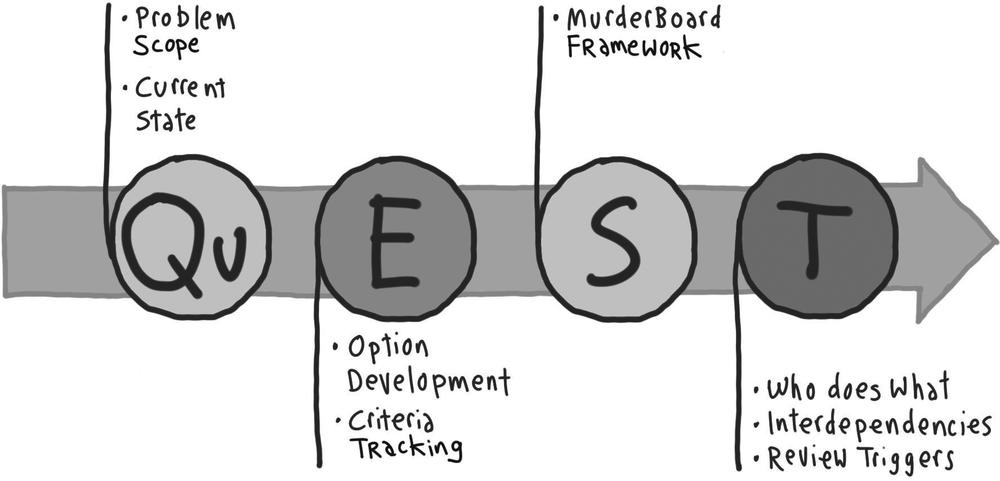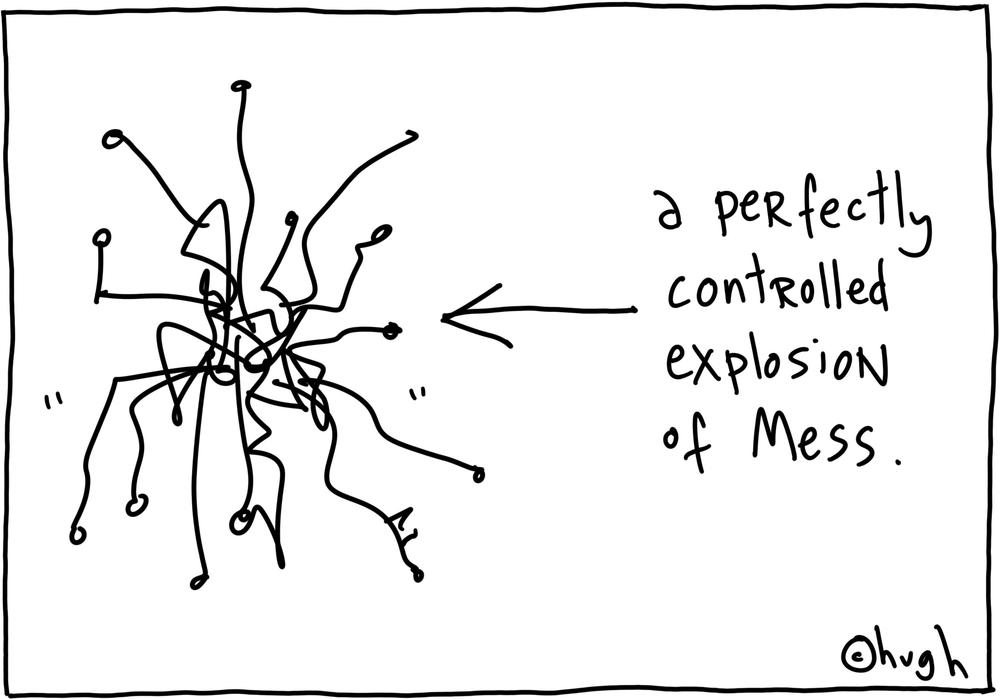Part II. The QuEST Process for Collaborative Strategy
We started this book with the notion that we need to change how business works. If business is to thrive, institutions must move from an us-versus-them opposition to an us-versus-opportunity stance. By doing strategy creation collaboratively, we are demanding that each of us take responsibility for the shared outcome, to improve business performance. We will move fast, get aligned, and welcome the creative conflict as we work together.
Part I, which we’ve just finished, covered how we need to show up at work to enable the creative and productive act of collaborative strategy. We focused on the role each of us has, and what we need to do as leaders.
We’re about to enter Part II, which covers the actions we need to take to reach the needed outcome. There are four stages of collaboration: Question, Envision, Select, and Take, or QuEST. These stages are shared in the four chapters that follow.
First up is “Question,” which focuses on seeing the full picture of what needs to be solved. We’ll learn a process for making sure the problem we have identified is the right problem, as well as getting a clear picture of “what is true,” so we have a solid basis for how to get from where we are to the future we decide we want. The most crucial aspect of this phase is getting early organizational understanding of the problem.
The second phase is “Envision,” where the emphasis is on creating options from a full marketplace of ideas within the organization. To know which options should matter more, we start to capture the criteria that come up, which will later shape the process of sorting ideas. Criteria form the lens through which we can see what matters to us in this time and situation.
Next, and perhaps most important, we enter the “Select” phase. This forces us to make the tough choices that business absolutely needs to make, to avoid the malaise caused by the perpetually repeated assertion that “we’ll do everything and do it all well.”
Last, we “Take” to create accountability in the system. “Take” means taking ownership, taking responsibility, and taking charge.
These four phases form the QuEST collaborative strategy framework (Figure 21).
You can get a quick sense of the framework by understanding the specific goal of each phase within the process, together with the approximate duration of each phase (Table 3).
|
PHASE/PHASE GOAL |
PHASE DURATION/COMMENTS |
|
1. Question: Know what you need to know |
Medium: 1–10 weeks |
|
The key here is to avoid shortcuts, and to rigorously collect all relevant information to enable a clear, deep, and rich understanding of the need or opportunity you seek to address. |
The duration depends on the size of your scope, people’s availability to discuss things, the priority within your organization, and the complexity of the issue. Cap at 10 weeks or less, since energy fades after that point. |
|
2. Envision: Create options that matter to this organization, at this time and place |
Short or long, depending on scope (typically 1–6 weeks) |
|
This creative phase focuses on the generation of strategic ideas from everywhere in the organization to find viable options, and the reasoning behind why those options matter. |
The duration depends on the geographies involved and how many disciplines and teams need to discuss options. |
|
3. Select: Make tough choices |
Short |
|
The goal of this phase is to use the original MurderBoarding process (described in Chapter 6) to sort ideas, and then fix, merge, tune, and toss them until one final winning strategy remains. |
Typically 1 day, but can be from 1 day to several days. |
|
4. Take: Create accountability |
Short |
|
The goal of this phase is to specify, with as much fidelity as possible, the following details of the final strategy: who is responsible, the actions required to execute the strategy, the changes needed to enable the strategy, and the means of detecting how well the strategy is hitting the intended target. |
Typically 1 day, but can be from 1 day to several days. Has a tee-up and post-process follow-up. Usually followed by a systemic process (like a quarterly business review). |
These four phases form the new building blocks of collaborative strategy creation. Each of the phases is collaborative in nature, but in different ways. The Question phase is about fully shared understanding of the problem, and so it depends upon all participants expressing their perspectives on the challenge. The Envision phase uses collaborative creativity to develop a pool of ideas for later selection. The Select phase pushes for explicit agreement (not tacit acceptance) on the choice of strategy option, and collaboration is essential for that. The Take phase is about working together to build a unified and detailed plan of action.
Before proceeding to the specifics of each phase, take a moment to consider the mindset you’ll need when using this process framework. Creating great strategy requires multiconversational, multidimensional discovery that involves three ongoing tasks: learning about what is relevant, defining what matters, and determining what the organization needs to do to make something new happen. As such, new information and new insights will sometimes mean you have to revisit previous phases so that your decisions can be aligned with the new information.
This potentially nonlinear aspect of strategy creation can seem messy, but this messiness is a byproduct of thoroughness, which always pays off in the final execution of a strategy (Figure 22).
The process framework helps you be explicit and informed about the choices you are making so you can move forward quickly.
When the process feels messy, that’s OK. Not only is it OK, it needs to be messy. Creating something new is almost never neat. The good news is that when you dig deep early, your team can discover potential obstacles that might otherwise have remained hidden during strategy creation. Digging deep is essential to preventing the Air Sandwich.
Your willingness to let the process be messy from time to time increases the chances of finding a strategy that will work, as well as discovering when a strategy won’t work. Both discoveries are valuable when making decisions about where to spend valuable resources.
By following the QuEST process framework, you make sure that:
You have unearthed the real problem in such a way that everyone sees it clearly.
Your team can generate many options, but still make tough decisions quickly.
The people who implement the final strategy understand the fundamental assumptions and the rationale behind the strategy, so they can explain what matters and why.
As a result, they know which trade-offs to make on the fly as they encounter unexpected things.
Ultimately, everyone involved will have an internalized understanding of why the strategy is important and what it is designed to do to serve the end goal of winning. They will not be just the “doers” but also “thinkers” who serve the organization.
After we finish Part II, we’ll step back into the larger view of the organizational rules of engagement to establish the new QuEST standards in an organization. That’s what Part III will detail.
For now, we need to dive deep into Part II. This methodology builds on the foundation of the “ways of being” covered in Part I. So let’s get into the specific phases.


